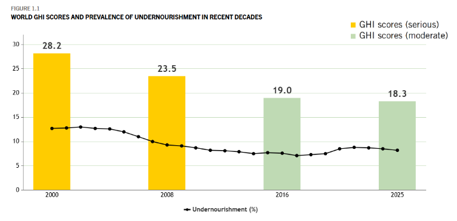Syllabus:
GS2: Issues relating to poverty and hunger.
Context: Recently, the report titled 2025 Global Hunger Index: 20 years of tracking progress: Time to recommit to zero hunger has been released.
More on the News
- The 20th edition of the Global Hunger Index presents a stark assessment of global progress toward achieving the United Nations’ Sustainable Development Goal of zero hunger by 2030.
Key Findings
- At the current pace, at least 56 countries will not reach low hunger, much less Zero Hunger, by 2030.
- If progress remains at the pace observed since 2016, low hunger at the global level may not be reached until 2137—more than a century away.
- The Global Hunger Index (GHI) 2025 score has barely improved since 2016.
- Hunger is classified as ‘serious’ or ‘alarming’ in 42 countries.
- The main causes of global hunger remain ongoing wars and armed conflicts, the consequences of climate change, and a lack of political will to act.
Regional disparities:

- Africa South of the Sahara
- Highest hunger levels globally
- Progress has slowed sharply since 2016
- Six countries — Democratic Republic of Congo, Liberia, Madagascar, Kenya, Somalia, and Zambia — face extremely alarming hunger levels.
South Asia
- One of the two most hunger-affected regions globally.
West Asia and North Africa
- Limited progress in reducing hunger since 2016
Latin America and the Caribbean
- Pace of hunger reduction has slowed considerably
East and Southeast Asia
- Overall low hunger levels maintained
- Progress has decelerated over the past decade
Europe and Central Asia
Regions with the lowest hunger levels in the world
India:
- India’s GHI score (2025) is 25.8, classified as serious, ranking 102 out of 123 countries.
- The score shows improvement from 29.3 in 2016 and 38.1 in 2000, earlier categorized as alarming.
- Child wasting remains critical at 18.7%, the second highest globally.
- Child stunting stands at 32.9%, the 21st highest, though reduced notably since 2000.
- Undernourishment affects 12% of the population, slightly higher than in 2016 after a temporary rise till 2021.
- Under-five mortality has improved significantly to 2.8%, marking steady progress in child survival.
About the Report
- The Global Hunger Index is a peer-reviewed annual report designed to comprehensively measure and track hunger at the global, regional, and country levels.
- It is jointly published by Concern Worldwide, Welthungerhilfe, and the Institute for International Law of Peace and Armed Conflict (IFHV).
- The aim of the GHI is to trigger action to reduce hunger around the world.
• Each country’s GHI score is calculated based on a formula that combines four indicators that together capture the multidimensional nature of hunger:
- Undernourishment: The share of the population whose caloric intake is insufficient;
- Child stunting: The share of children under the age of five who have low height for their age, reflecting chronic undernutrition;
- Child wasting: The share of children under the age of five who have low weight for their height, reflecting acute undernutrition; and
- Child mortality: The share of children who die before their fifth birthday, reflecting in part the fatal mix of inadequate nutrition and unhealthy environment.

